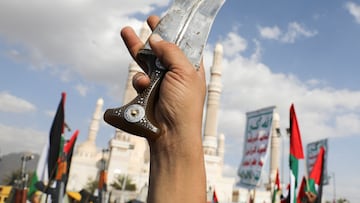Who are the Houthis, what is happening in Yemen and why have the US and the UK attacked them?
The ongoing conflict in the Middle East has the potential to become wider after the US and UK attacked Houthi-controlled positions in Yemen.

Beyond Israel and Hamas, the Houthis are another focal point in the ongoing conflict in the Middle East. This Yemeni militia, supported by Iran, emerged in the 1990s with the aim of opposing the influence exerted by Saudi Arabia in Yemen, located in a strategic location on the Arabian Peninsula.
This group takes the name of its founder, Hussein Badreddin Al Houthi, and adhere to a branch of Shia Islam known as Zaidism. Currently, the leader of this organization is his brother, Abdul Malik, after the former was assassinated in 2004. In addition to having the support of Tehran, the Houthis have been supporting Hamas in its war against the Israeli Defense Forces since the attack carried out by the terrorist group that control the Gaza Strip on October 7, which killed an estimated 1,200 and resulted in around 250 being taken hostage.
Also known as Ansar Allah (Supporters of God), the Houthis are part of the so-called ‘axis of resistance’, led by countries such as Syria and Iran, which is also made up of other militias such as Hamas and Hezbollah. The motto of this axis is “God is great, death to America, death to Israel, curse on the Jews and victory of Islam.” There are roughly 20,000 Houthi fighters who exercise control over most of the north and west of Yemen.
The close ties with Tehran are motivated by its enmity with the Saudis and its defense of the Shiite branch of Islam. In 2015, a new civil war broke out in the country following the capture of Sana’a, the capital of the Yemen, which is why the president of the country that year, Abd Rabbu Mansour Hadi, fled abroad, being forced to ask Saudi Arabia and the United Arab Emirates for help to restore order in the country.
Attacks on ships in the Red Sea
Unemployment, inflation and limited social services, along with the armed conflict that has been fought in the country in recent years, have caused constant instability in Yemen. The ongoing civil war has plunged the country into what the United Nations has described as “one of the world’s largest humanitarian crises.” Added to this are the attacks carried out by the Houthis against commercial shipping, where they have launched missiles and drones at vessels in the waters off its coast.
The Red Sea has become a leading scene of attacks by the militia against ships that transit near the coasts controlled by the group, especially ships linked to Israel and lately, against American and British vessels. In recent months, they captured a commercial ship and attacked several cargo ships. The affected route, the Bab al-Mandeb Strait, is crucial for global oil and natural gas trade, along with other consumer goods cargo.
One of the most notorious attacks was the one carried out against the destroyer ‘USS Carney’ and the British cargo ship ‘Unity Explorer’. The US authorities assured that the downing of the drone occurred “in self-defense” and that “there were no injuries to personnel or damage” to any vessel.
These ongoing attacks and disruption to trade triggered large-scale joint airstrikes by the United States and United Kingdom on Houthi-controlled positions in Yemen. The group has vowed retaliation and there are concerns that affliated groups across the Middle East may attack US and British forces in the region, further expanding the raging Israeli-Hamas conflict.





